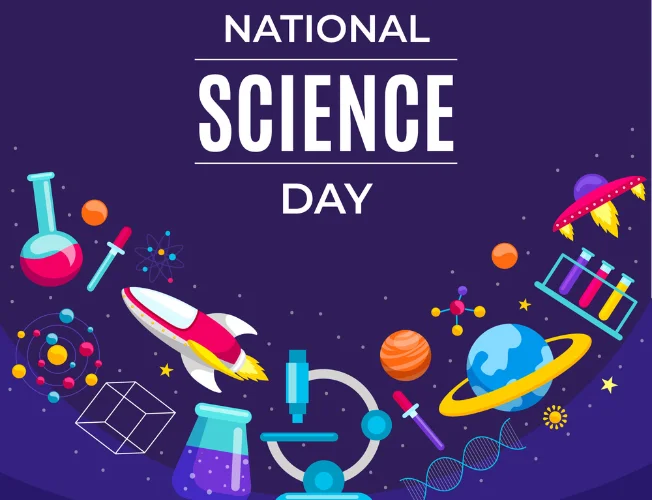In India, February 28th holds a special significance. It’s not just another day on the calendar; it’s National Science Day, a day dedicated to celebrating the nation’s scientific achievements and fostering a deeper appreciation for science in our daily lives. This day marks the anniversary of Sir C.V. Raman’s groundbreaking discovery of the “Raman Effect” in 1928, a feat that later earned him the Nobel Prize in Physics in 1930.
A Look Back: The History and Significance of National Science Day
The journey of National Science Day began in 1986 when the National Council for Science and Technology Communication (NCSTC) proposed designating February 28th as a day dedicated to science. The proposal resonated with the government, leading to the official inauguration of the day’s celebrations in 1987. Since then, National Science Day has evolved into a significant annual event that aims to:
- Raise Public Awareness: Spark public interest and understanding of science and its applications in everyday life. The day aims to bridge the gap between theoretical knowledge and practical applications by highlighting how scientific advancements impact our lives in tangible ways.
- Showcase Achievements: Celebrate the contributions of Indian scientists and their tireless efforts in propelling the nation’s scientific progress. National Science Day serves as a platform to acknowledge the immense contributions of individuals like Sir C.V. Raman and countless others who have dedicated their lives to scientific breakthroughs and advancements.
- Encourage Dialogue: Foster critical thinking and debate about scientific issues and advancements. By creating an open forum for discussion, National Science Day encourages both experts and the public to engage in constructive conversations about the ethical and societal implications of scientific progress.
- Foster Innovation: Promote the adoption and development of new technologies for scientific progress. National Science Day serves as a call to action to embrace innovation and encourage the development of new technologies that can address global challenges and enhance societal well-being.
- Popularize Science: Make science and technology more accessible and engaging, particularly for the younger generation. By organizing interactive events and fostering a curious and inquisitive mindset, National Science Day aims to ignite a passion for science among young minds and inspire them to explore future careers in scientific fields.
Understanding the “Raman Effect” and Its Widespread Impact
The discovery of the Raman Effect by C.V. Raman, during his time at the Indian Association for the Cultivation of Science, stands at the heart of National Science Day celebrations. This crucial discovery revolutionized our understanding of light-matter interaction. The phenomenon, simply put, explains the change in a light beam’s wavelength when it interacts with molecules in a material. This seemingly simple interaction has far-reaching applications in various fields, including:
- Material Analysis: The Raman Effect is used to analyze the composition and structure of various materials, providing valuable insights into their properties and applications.
- Chemical and Biological Identification: This phenomenon plays a vital role in identifying different chemical and biological substances, aiding in medical diagnostics, forensic analysis, and drug discovery.
- Advanced Materials and Technologies: The Raman Effect offers valuable insights into the properties of materials, paving the way for the development of new and improved materials with specific functionalities.
National Science Day: Bringing Science Closer to the Public
The Department of Science and Technology (DST) acts as the nodal agency for nationwide celebrations, leading and coordinating the festivities across research institutions, universities, and scientific organizations. These celebrations typically involve a diverse range of activities, designed to engage the public and inspire them:
- Student Science Projects: This segment provides a platform for young minds to showcase their scientific exploration and research. Students present their science projects, fostering creativity, critical thinking, and a passion for scientific inquiry.
- Research Showcases: National and state-level research institutions and universities use this opportunity to showcase their cutting-edge research and advancements. These exhibits offer the public a glimpse into the intricate world of scientific exploration and its potential impact.
- Public Engagement Activities: These activities aim to make science accessible and engaging for the broader community. Public lectures, discussions, science exhibitions, skywatching sessions, quizzes, and live demonstrations allow individuals of all ages to interact with science, ask questions, and gain a deeper understanding of its various facets.
Looking Beyond: The Enduring Importance of National Science Day
National Science Day serves as a crucial reminder of the vital role science plays in shaping our world. It celebrates the past, inspires the present, and encourages a future driven by scientific innovation and responsible advancements. By fostering a culture of scientific curiosity and appreciation, we can continue to pave the way for a more sustainable, healthy, and prosperous future for generations to come.
National Science Day serves as a springboard for promoting responsible scientific practices and fostering ethical considerations in the pursuit of scientific knowledge. It encourages collaboration, critical thinking, and open dialogue to ensure hat scientific advancements benefit humanity and contribute to a better future for all. Additionally, National Science Day serves as a crucial platform for:
- Bridging the Gender Gap: The day emphasizes the need for greater participation of women in science and technology fields. Events and initiatives are organized to encourage young girls and women to pursue careers in science, research, and innovation.
- Promoting Science Communication: National Science Day facilitates efforts to bridge the gap between scientists and the public. By promoting clear and engaging communication, scientists can share their knowledge and research findings in a way that is accessible and understandable to the public, fostering informed discussions and engagement.
- Addressing Global Challenges: The day highlights how scientific advancements can play a crucial role in addressing various global challenges, such as climate change, food security, and resource management. By encouraging collaboration among scientists, policymakers, and the public, National Science Day strives to find solutions through scientific innovation and responsible practices.
Beyond National Science Day: Embracing a Culture of Scientific Thinking
While National Science Day serves as a dedicated platform for celebrating science, it is vital to cultivate a culture of scientific thinking throughout the year. This involves:
- Encouraging Curiosity: Nurturing a child’s natural curiosity towards the world around them is crucial for fostering a lifelong interest in science. This can be achieved by encouraging observation, asking questions, and exploring the answers through age-appropriate experiments and learning experiences.
- Integrating Science in Daily Life: By highlighting the presence of science in our everyday lives, from the food we eat to the technology we use, we can bridge the gap between theoretical knowledge and practical applications. This helps individuals see the relevance of science in their own lives.
- Supporting Science Education: Ensuring quality science education plays a vital role in developing a scientifically literate society. This involves providing access to well-equipped laboratories, qualified educators, and engaging learning materials that encourage critical thinking and problem-solving skills.
National Science Day serves as a beacon of inspiration, reminding us of the transformative power of science and its potential to shape a brighter future. By actively engaging with science, nurturing scientific curiosity, and fostering responsible and ethical advancements, we can leverage the power of science to address global challenges, improve lives, and build a more sustainable and equitable world for all. Let us celebrate National Science Day as a stepping stone towards a future where scientific progress and human well-being go hand in hand.





